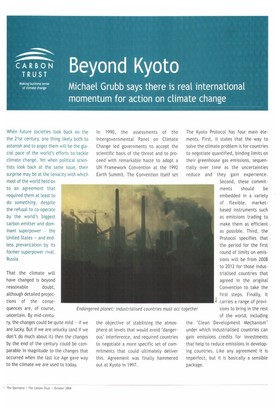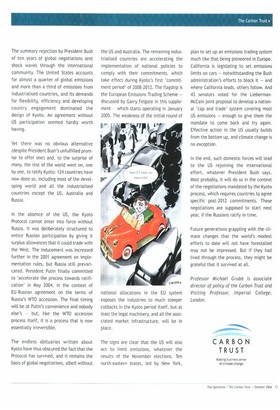Beyond Kyoto
Michael Grubb says there is real international momentum for action on climate change
When future societies look back on the the 21st century, one thing likely both to astonish and to anger them will be the glacial pace of the world's efforts to tackle climate change. Yet when political scientists look back at the same issue, their surprise may be at the tenacity with which most of the world held on to an agreement that required them at least to do something, despite the refusal to co-operate by the world's biggest carbon emitter and dominant superpower — the United States — and endless prevarication by its former superpower rival, Russia.
That the climate will have changed is beyond
reasonable doubt, although detailed projections of the consequences are, of course, uncertain. By mid-century, the changes could be quite mild — if we are lucky. But if we are unlucky (and if we don't do much about it) then the changes by the end of the century could be comparable in magnitude to the changes that occurred when the last Ice Age gave way to the climate we are used to today.
Endange
In 1990, the assessments of the Intergovernmental Panel on Climate Change led governments to accept the scientific basis of the threat and to proceed with remarkable haste to adopt a UN Framework Convention at the 1992 Earth Summit, The Convention itself set the objective of stabilising the atmosphere at levels that would avoid 'dangerous' interference, and required countries to negotiate a more specific set of commitments that could ultimately deliver this. Agreement was finally hammered out at Kyoto in 1997. The Kyoto Protocol has four main elements. First, it states that the way to solve the climate problem is for countries to negotiate quantified, binding limits on their greenhouse gas emissions, sequentially over time as the uncertainties reduce and they gain experience. Second, these commit ments should be embedded in a variety of flexible, marketbased instruments such as emissions trading to make them as efficient as possible. Third, the Protocol specifies that the period for the first round of limits on emissions will be from 2008 to 2012 for those industrialised countries that agreed in the original Convention to take the first steps. Finally, it carries a range of provisions to bring in the rest of the world, including the 'Clean Development Mechanism' under which industrialised countries can gain emissions credits for investments that help to reduce emissions in developing countries. Like any agreement it is imperfect, but it is basically a sensible package. The summary rejection by President Bush of ten years of global negotiations sent shock waves through the international community. The United States accounts for almost a quarter of global emissions and more than a third of emissions from industrialised countries, and its demands for flexibility, efficiency and developing country engagement dominated the design of Kyoto. An agreement without US participation seemed hardly worth having.
Yet there was no obvious alternative (despite President Bush's unfulfilled promise to offer one) and, to the surprise of many, the rest of the world went on, one by one, to ratify Kyoto: 124 countries have now done so, including most of the developing world and all the industrialised countries except the US, Australia and Russia.
In the absence of the US, the Kyoto Protocol cannot enter into force without Russia. It was deliberately structured to entice Russian participation by giving it surplus allowances that it could trade with the West. The inducement was increased further in the 2001 agreement on implementation rules, but Russia still prevaricated. President Putin finally committed to 'accelerate the process towards ratification in May 2004, in the context of EU-Russian agreement on the terms of Russia's WTO accession. The final timing will be at Putin's convenience and nobody else's — but, like the WTO accession process itself, it is a process that is now essentially irreversible.
The endless obituaries written about Kyoto have thus obscured the fact that the Protocol has survived, and it remains the basis of global negotiations, albeit without the US and Australia. The remaining industrialised countries are accelerating the implementation of national policies to comply with their commitments, which take effect during Kyoto's first 'commitment period' of 2008-2012. The flagship is the European Emissions Trading Scheme — discussed by Garry Felgate in this supplement which starts operating in January 2005. The weakness of the initial round of national allocations in the EU system exposes the industries to much steeper cutbacks in the Kyoto period itself, but at least the legal machinery, and all the associated market infrastructure, will be in place.
The signs are clear that the US will also act to limit emissions, whatever the results of the November elections. Ten north-eastern states, led by New York, plan to set up an emissions trading system much like that being pioneered in Europe. California is legislating to set emissions limits on cars — notwithstanding the Bush administration's efforts to block it — and where California leads, others follow. And 43 senators voted for the LiebermanMcCain joint proposal to develop a national 'cap and trade' system covering most US emissions — enough to give them the mandate to come back and try again. Effective action in the US usually builds from the bottom up, and climate change is no exception.
In the end, such domestic forces will lead to the US rejoining the international effort, whatever President Bush says. Most probably, it will do so in the context of the negotiations mandated by the Kyoto process, which requires countries to agree specific post-2012 commitments. These negotiations are supposed to start next year, if the Russians ratify in time.
Future generations grappling with the climate changes that the world's modest efforts to date will not have forestalled may not be impressed. But if they had lived through the process, they might be grateful that it survived at all.
Professor Michael Grubb is associate director of policy of the Carbon Trust and Visiting Professor, Imperial College, London.



















































































































 Previous page
Previous page